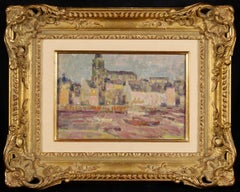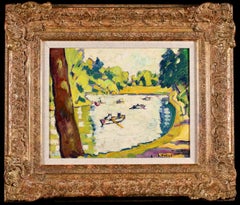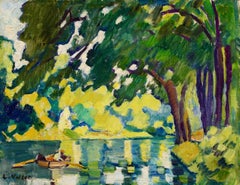Want more images or videos?
Request additional images or videos from the seller
1 of 16
Louis AnquetinElegante sur Les Grands Boulevards - Modernist Figurative Oil by Louis Anquetinc.1895
c.1895
$9,092.96List Price
About the Item
- Creator:Louis Anquetin (1861 - 1932, French)
- Creation Year:c.1895
- Dimensions:Height: 16.5 in (41.91 cm)Width: 20 in (50.8 cm)
- Medium:
- Movement & Style:
- Period:
- Condition:Very good condition.
- Gallery Location:Marlow, GB
- Reference Number:Seller: LFA02481stDibs: LU415316513862
About the Seller
5.0
Gold Seller
Premium sellers maintaining a 4.3+ rating and 24-hour response times
Established in 2001
1stDibs seller since 2016
709 sales on 1stDibs
Authenticity Guarantee
In the unlikely event there’s an issue with an item’s authenticity, contact us within 1 year for a full refund. DetailsMoney-Back Guarantee
If your item is not as described, is damaged in transit, or does not arrive, contact us within 7 days for a full refund. Details24-Hour Cancellation
You have a 24-hour grace period in which to reconsider your purchase, with no questions asked.Vetted Professional Sellers
Our world-class sellers must adhere to strict standards for service and quality, maintaining the integrity of our listings.Price-Match Guarantee
If you find that a seller listed the same item for a lower price elsewhere, we’ll match it.Trusted Global Delivery
Our best-in-class carrier network provides specialized shipping options worldwide, including custom delivery.You May Also Like
Lalibela
Located in Wien, 9
Egon Hofmann war nicht nur als Maler wichtig und wegweisend, sondern auch als Netzwerker, der als Gründer und langjähriger Präsident der Künstlervereinigung „März“ eine wichtige Roll...
Category
1960s Modern Figurative Paintings
Materials
Oil, Wood Panel
Lerchenfeldner Gürtel (Vienna)
By Ernst Huber
Located in Wien, 9
Ernst Huber war eine zeitlang am Kunstmarkt aufgrund einer Nachlassauktion so omnipräsent, dass mir etwas das Entdeckungsinteresse an diesem sehr guten Kün...
Category
1920s Modern Landscape Paintings
Materials
Oil, Panel
City Side (Modern Cityscape Oil Painting of Brooklyn Rooftops)
By Patty Neal
Located in Hudson, NY
oil paint on panel
12 x 12 inches
This contemporary cityscape oil painting is painted on wood panel in a realistic style. The scene is of a Brooklyn skyline where old water towers...
Category
2010s Modern Landscape Paintings
Materials
Oil, Wood Panel
Rooftops Power Lines, Five & Diamond: Abstract Cityscape Painting of Hudson NY
By Ricardo Mulero
Located in Hudson, NY
Abstract cityscape painting of Hudson, NY rooftops with accents of pink, magenta, green, yellow and teal
"Rooftops Power Lines and Five & Diamond," by Hudson, NY based artist, Ricardo Mulero
12 x 6 inch oil on wood panel, Painted in 2021
Excellent condition, ready to hang as is
Signed, lower left
Ricardo Mulero is fascinated with capturing the brilliance of light and the contrast of natural beauty with utilitarian landscapes. Here, he abstracted the city skyline of Hudson, NY. Buildings and rooftops in shades of magenta, teal, and green are segmented in the foreground and cropped with black power lines. A soft yellow sky is layered with thin strokes of gesturally applied pale blue paint, furthering abstracting the city landscape. The piece is in excellent condition and ready to hang as is. The sides are painted a very dark, warm magenta so framing is not necessary.
About the Artist:
Growing up in Puerto Rico, I observed how people and nature could co-exist in harmony. Today, that principle guides my design and artistic work. My paintings are expressions that draw upon my life experiences, traditions, and surroundings. These unique environments inspire my oil paintings: Puerto Rico, where I grew up, New York City, Fire Island Pines...
Category
2010s Modern Landscape Paintings
Materials
Oil, Wood Panel
$850
H 12 in W 6 in D 2 in
41st & 10th: Abstract WPA Style Cityscape, New York City Rooftops & Water Tower
By Ricardo Mulero
Located in Hudson, NY
Cityscape painting on muslin of iconic New York City water towers against an abstract maroon, silver, and blue rooftop skyline
"41st & 10th" by Hudson, NY based artist, Ricardo Muler...
Category
2010s Modern Landscape Paintings
Materials
Oil, Gesso, Wood Panel
Ricardo Mulero 41st & 10th: Abstract WPA Style Cityscape, New York City Rooftops & Water Tower, 2018
$5,000
H 43 in W 27 in D 2 in
English Snow covered Winter Landscape with people by a house, rising Sun
Located in Woodbury, CT
Peter has an absolute love of oil painting and especially admires the masters of Dutch Painting of the 17th Century, which is reflected in his own work. Since 1995, after seeing the work of Estonian artist Olav Maran, Peter decided to review his paintings and started researching ‘Still Life’ painters such as Willem Kalf and De Heem. After experimenting with priming his own panels and canvases with different colours, then painting with thick and thin paint and glazing on top, in the way of the old masters, he has developed a style with detail and atmosphere that is essential in his portrayal of fine wine, fruit and cheeses etc.
In a quirky and sometimes conceptual world, Peter makes no apologies for producing traditional subjects where the craftsmanship is evident in every brushstroke. His paintings bring much joy and pleasure to those who understand he has an obvious and underlying love of handling paint and observing his subject using techniques that take many years to acquire. Recently he has changed the view point for some of his paintings, to give them a bold contemporary look.
Peter Kotka...
Category
Early 2000s Modern Landscape Paintings
Materials
Oil, Wood Panel
$2,950
Free Shipping
H 16 in Dm 12 in
English Snow covered Winter Landscape with people by a house, rising Sun
Located in Woodbury, CT
Peter has an absolute love of oil painting and especially admires the masters of Dutch Painting of the 17th Century, which is reflected in his own work. Since 1995, after seeing the work of Estonian artist Olav Maran, Peter decided to review his paintings and started researching ‘Still Life’ painters such as Willem Kalf and De Heem. After experimenting with priming his own panels and canvases with different colours, then painting with thick and thin paint and glazing on top, in the way of the old masters, he has developed a style with detail and atmosphere that is essential in his portrayal of fine wine, fruit and cheeses etc.
In a quirky and sometimes conceptual world, Peter makes no apologies for producing traditional subjects where the craftsmanship is evident in every brushstroke. His paintings bring much joy and pleasure to those who understand he has an obvious and underlying love of handling paint and observing his subject using techniques that take many years to acquire. Recently he has changed the view point for some of his paintings, to give them a bold contemporary look.
Peter Kotka...
Category
Early 2000s Modern Landscape Paintings
Materials
Oil, Wood Panel
$2,950
Free Shipping
H 16 in Dm 12 in
English Snow covered Winter Landscape with people by a house, rising Sun
Located in Woodbury, CT
Peter has an absolute love of oil painting and especially admires the masters of Dutch Painting of the 17th Century, which is reflected in his own work. Since 1995, after seeing the work of Estonian artist Olav Maran, Peter decided to review his paintings and started researching ‘Still Life’ painters such as Willem Kalf and De Heem. After experimenting with priming his own panels and canvases with different colours, then painting with thick and thin paint and glazing on top, in the way of the old masters, he has developed a style with detail and atmosphere that is essential in his portrayal of fine wine, fruit and cheeses etc.
In a quirky and sometimes conceptual world, Peter makes no apologies for producing traditional subjects where the craftsmanship is evident in every brushstroke. His paintings bring much joy and pleasure to those who understand he has an obvious and underlying love of handling paint and observing his subject using techniques that take many years to acquire. Recently he has changed the view point for some of his paintings, to give them a bold contemporary look.
Peter Kotka...
Category
Early 2000s Modern Landscape Paintings
Materials
Oil, Wood Panel
$2,950
Free Shipping
H 16 in Dm 12 in
Love Bubbles (Oil Painting, Impasto, Impressionism, Colorful, Pink, Grey, Warm)
Located in Kansas City, MO
Genevieve Hamel
Love Bubbles
Oil on Wood Panel
Year: 2024
Size: 12 x 12 x 1.5 inches
Signed by hand
COA provided
*wired and ready to hang
Genevieve Hamel’s passions for design and...
Category
2010s Modern Figurative Paintings
Materials
Oil, Wood Panel
Genevieve HamelLove Bubbles (Oil Painting, Impasto, Impressionism, Colorful, Pink, Grey, Warm), 2024
$495 Sale Price
44% Off
H 12 in W 12 in D 1.625 in
Sky is the Limit (Oil Painting, Impasto, Impressionism, Colorful, Pastel, Cool)
Located in Kansas City, MO
Genevieve Hamel
Sky is the Limit
Oil on Wood Panel
Year: 2024
Size: 36 x 18 x 1.625 inches
Signed by hand
COA provided
*wired and ready to hang
Genevieve Hamel’s passions for desi...
Category
2010s Modern Figurative Paintings
Materials
Oil, Wood Panel
Genevieve HamelSky is the Limit (Oil Painting, Impasto, Impressionism, Colorful, Pastel, Cool), 2024
$1,666 Sale Price
24% Off
H 36 in W 18 in D 1.625 in
More From This Seller
View AllSaint Servan - Brittany - Post Impressionist Landscape by Henri Le Sidaner
By Henri Le Sidaner
Located in Marlow, Buckinghamshire
Signed post impressionist landscape oil on panel by French painter Henri le Sidaner. The work depicts a nighttime view of the bay at Saint Servan, Brittany in the north of France. Th...
Category
Early 20th Century Post-Impressionist Landscape Paintings
Materials
Oil, Panel
Barques au Bois de Boulogne - Fauvist Landscape Oil Painting by Louis Valtat
By Louis Valtat
Located in Marlow, Buckinghamshire
Signed fauvist oil on canvas laid on panel riverscape circa 1925 by French painter Louis Valtat. The work depicts several boats being rowed on River Seine in Bois de Boulogne - a for...
Category
1920s Fauvist Landscape Paintings
Materials
Oil, Panel, Canvas
Le hameau en ete - Post Impressionist Landscape Oil Painting by Victor Charreton
By Victor Charreton
Located in Marlow, Buckinghamshire
Signed oil on panel landscape circa 1930 by French post impressionist painter Victor Charreton. This stunning work depicts a view of a French hamlet in summer - the buildings in the ...
Category
1930s Post-Impressionist Landscape Paintings
Materials
Oil, Panel
Lac du Bois de Boulogne - Fauvist Landscape Oil Painting by Louis Valtat
By Louis Valtat
Located in Marlow, Buckinghamshire
Signed fauvist oil on canvas laid on panel riverscape circa 1925 by French painter Louis Valtat. The work depicts a boat being rowed on the Bois de Boulogne lake in Paris, France. It...
Category
1920s Fauvist Landscape Paintings
Materials
Canvas, Oil, Panel
The Arrival - New York - Post Impressionist Landscape Oil by Henri Le Sidaner
By Henri Le Sidaner
Located in Marlow, Buckinghamshire
Signed divisionist landscape oil on panel by French post impressionist painter Henri le Sidaner. This stunning piece depicts high rise buildings of New York at nighttime. Lights illuminate the windows in an otherwise dark scene. A steam boat sails along the river.
Signature:
Signed lower left
Dimensions:
Framed: 24.5"x20"
Unframed: 16"x11.5"
Provenance:
Louis Le Sidaner collection
Etienne Le Sidaner collection
Private collection, France
Exhibitions :
Paris, Musée Galliera, "Rétrospective Henri Le Sidaner", April 1948
Brussels, Galerie de l'Art Belge, "Rétrospective Henri Le Sidaner", April-May 1951
Literature:
This work is accompanied by a photo certificate of authenticity from Yann Farinaux Le Sidaner
This work will be included in the forthcoming supplement to the catalogue raisonne currently under preparation by Yann Farinaux Le Sidaner
This work is the only recorded painting...
Category
1930s Pointillist Landscape Paintings
Materials
Oil, Panel
Tea at Chateau de Madrid - Modernist Figurative Oil by Anne Estelle Rice
By Anne Estelle Rice
Located in Marlow, Buckinghamshire
Signed and titled oil on panel figures in landscape by American painter Anne Estelle Rice. This beautiful and colourful piece depicts groups of elegantly dressed people enjoying tea ...
Category
1910s Expressionist Figurative Paintings
Materials
Oil, Panel
Price Upon Request
Free Shipping
Recently Viewed
View AllMore Ways To Browse
19th Century Male Portrait French
Portrait Of Marguerite
Male Bust Nude
Les Grands Boulevards
Portrait Of An Actor
Girl Horse Painting
Grosso Giacomo
Guirand De Scevola
Isami Doi
Iyiola Odunayo
Jean Beraud
Jean Jacques Henner Oil Painting
Joyce Roybal
Lady Godiva
Lingerie Painting
Luca Giordano
Mother With Children Painting
Nugzar Kakhiani



